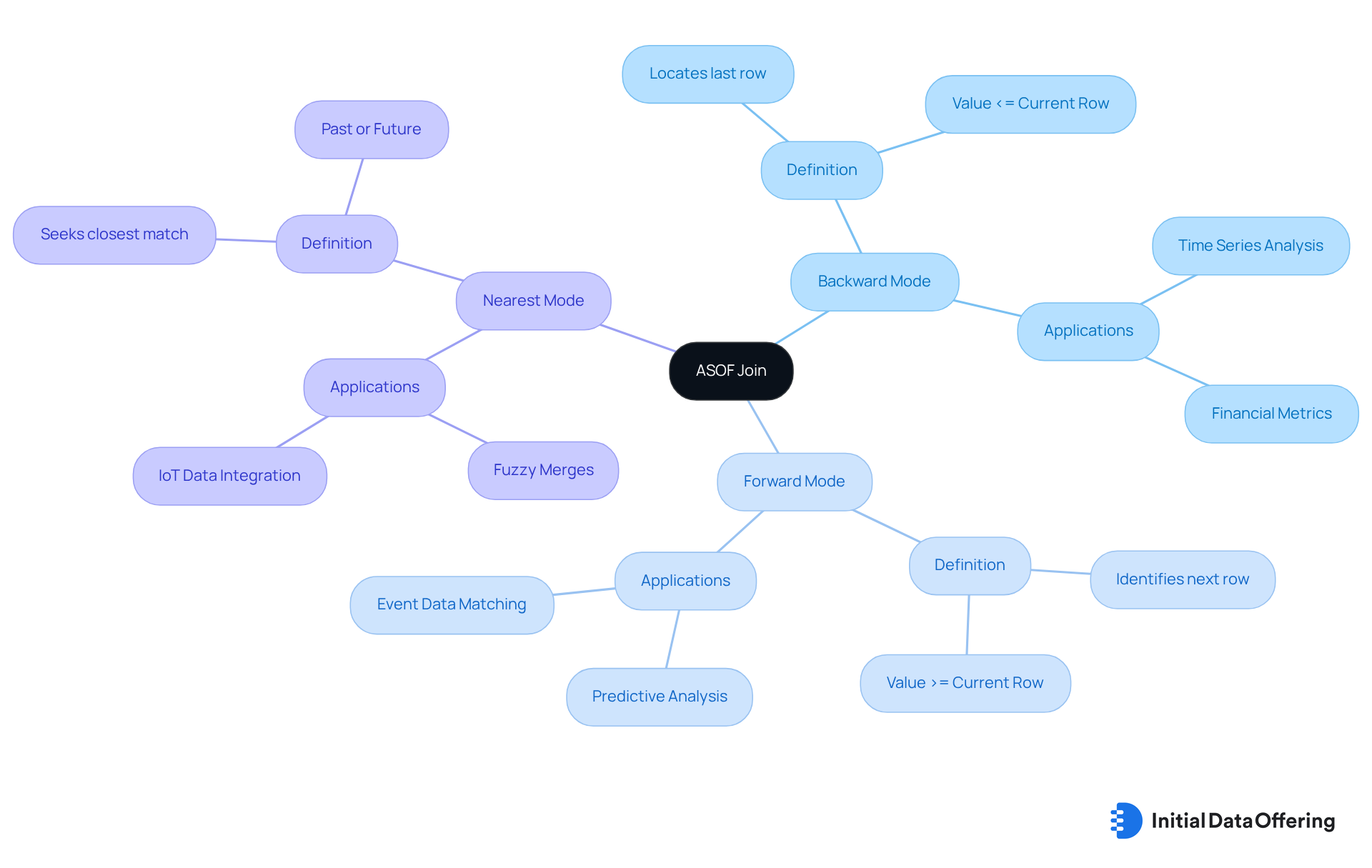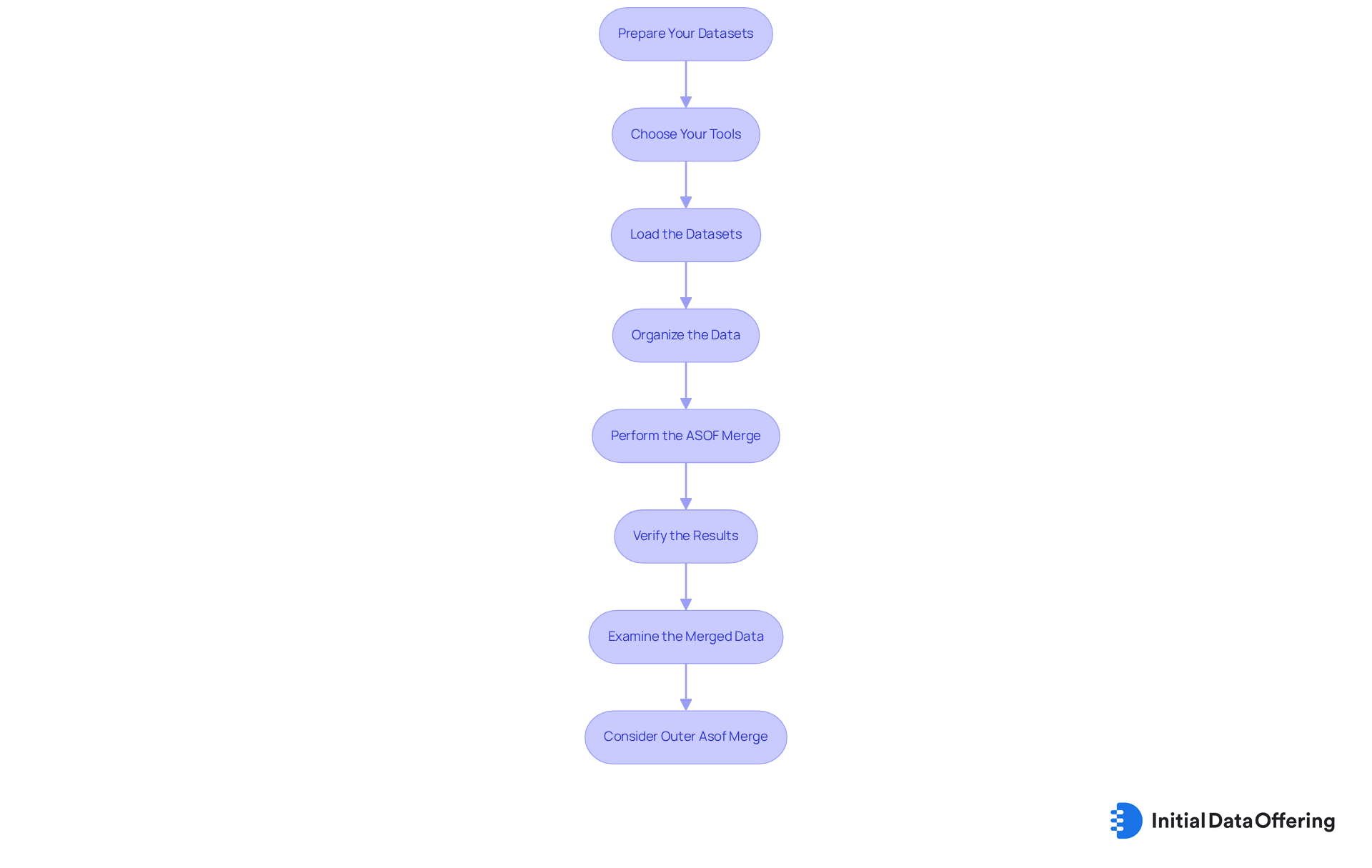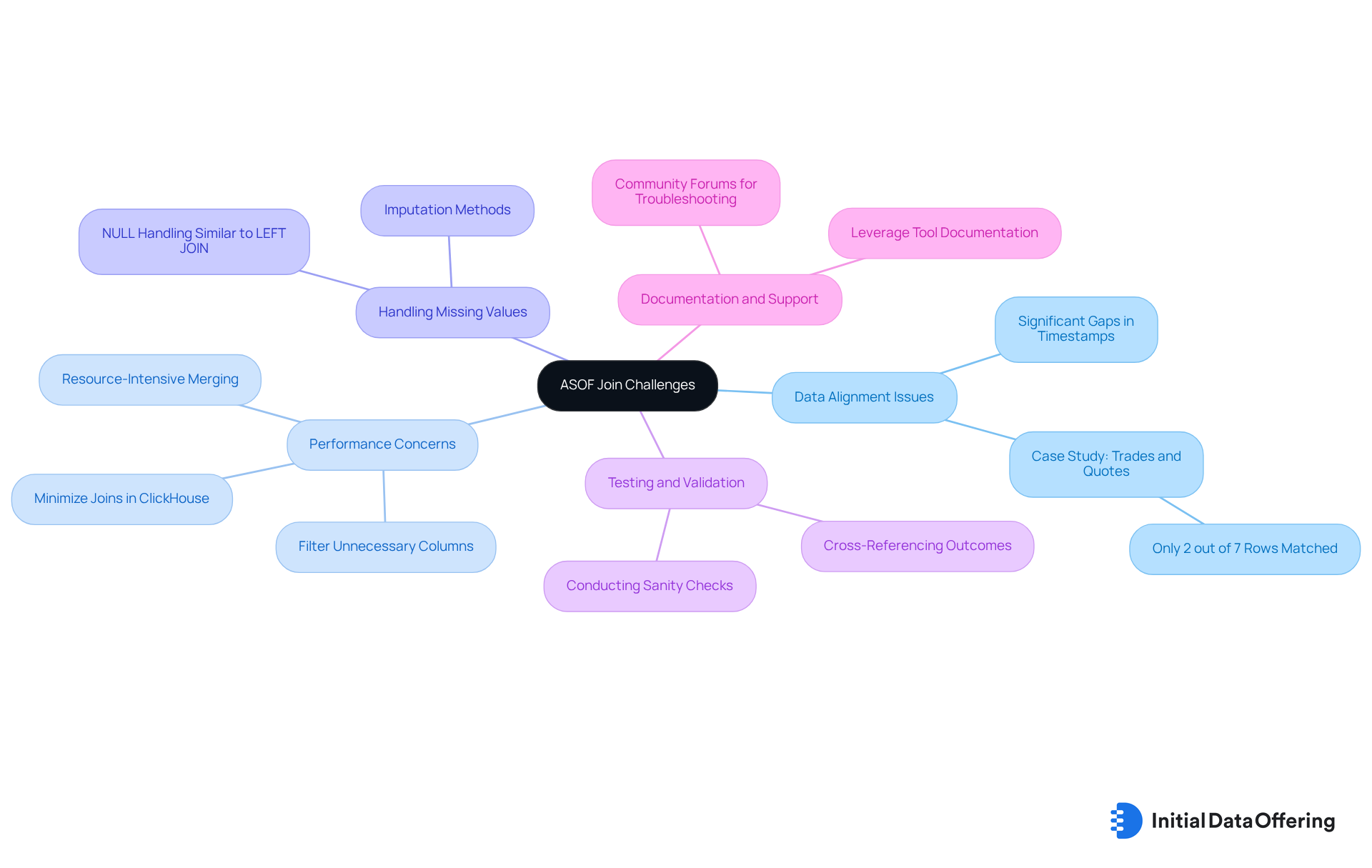Master ASOF Join: Step-by-Step Implementation Guide

Master ASOF Join: Step-by-Step Implementation Guide
Overview
This article presents a comprehensive step-by-step guide on implementing an ASOF join, a method for merging datasets based on a shared key while aligning them according to temporal references. It outlines the essential preparations, tools, and processes involved in this technique. By addressing common challenges and limitations, the article ensures accurate and efficient data analysis.
How can understanding the ASOF join enhance your data integration efforts? The insights provided will not only clarify the implementation process but also illustrate the significant benefits of using this method in your analytical work.
Introduction
Understanding the intricacies of data analysis often hinges on the ability to align disparate datasets. The ASOF join is a powerful technique that enables analysts to synchronize data based on temporal references, even in the absence of timestamps. This guide explores the step-by-step implementation of ASOF joins, detailing its various modes and practical applications. However, as with any analytical method, challenges such as data alignment issues and performance concerns arise. This prompts the question: how can analysts effectively navigate these hurdles to harness the full potential of ASOF joins in their analyses?
Understand ASOF Join: Definition and Purpose
Asof join' represents a robust method in information analysis, effectively combining two datasets based on a shared key while aligning them according to a specific temporal reference. This technique proves particularly advantageous for sequences where collections may lack corresponding timestamps yet require synchronization to the nearest prior moment. The primary objective of this method is to facilitate accurate comparisons and analyses by ensuring that data points are aligned as closely as possible in duration. This alignment is essential for deriving actionable insights from datasets.
The three primary modes of asof join are:
- Backward: The backward mode uses an asof join to locate the last row in the other table where the value is less than or equal to the value in the current row.
- Forward: In contrast, the forward mode identifies the next row asof join where the value is greater than or equal to the current row.
- Nearest: The nearest mode, however, employs an asof join to seek the closest match in the other table, regardless of whether it lies in the past or future.
This flexibility empowers analysts to select the most suitable method tailored to their specific alignment requirements, including the use of an asof join.
Consider a dataset containing stock prices alongside another dataset of economic indicators. A temporal connection allows analysts to explore how changes in economic conditions influence stock performance over time. This capability is vital in finance, where understanding the temporal relationship between various information streams can lead to more informed decision-making and strategic planning. Moreover, this technique simplifies complex queries that would otherwise require elaborate SQL expressions, enhancing performance and usability for those evaluating time-dependent information through an asof join. By using an asof join to bridge gaps in time-related data, the method enriches the depth of analysis, establishing itself as an essential tool for market research and financial evaluation.
It is crucial to note that the equals operator is not supported in the time-based combination, a critical detail for users implementing this technique. Furthermore, CedarDB's support for temporal joins facilitates fuzzy merges, particularly beneficial for time series data, enabling users to merge two tables based on the nearest matching attribute.

Implement ASOF Join: Step-by-Step Guide
To implement an ASOF Join effectively, follow these structured steps:
-
Prepare Your Datasets: Ensure both datasets are clean and correctly formatted. Each should include a common key, such as a unique identifier, along with a timestamp column to facilitate accurate joining. This preparation is crucial as it lays the foundation for a successful merge.
-
Choose Your Tools: Select a programming language or software that supports time-based combination operations. Popular options include Python, which utilizes the pandas library, or SQL databases, widely recognized for their data manipulation capabilities. Choosing the right tool can significantly enhance your workflow efficiency.
-
Load the Datasets: Import your datasets into your chosen environment. For instance, in Python, you can load CSV files using
pandas.read_csv(). This step is essential for making your data accessible for analysis. -
Organize the Data: Arrange both datasets according to the timestamp column, which is crucial for the time-based merging to operate accurately. In pandas, this can be accomplished with
df.sort_values(by='timestamp'). Proper organization ensures that the merging process functions as intended. -
Perform the ASOF Merge: Execute the appropriate function for the merge. In pandas, this is done with
pd.merge_asof(), where you specify the key and timestamp columns. Be aware that identical matches in the time-based join can lead to non-deterministic results, so it's crucial to handle this carefully. Understanding this aspect can prevent potential issues in your analysis. -
Verify the Results: After the join, check the resulting dataset to ensure accurate merging. Look for discrepancies or missing values that may need correction. It's also advisable to explicitly list the columns you want to retrieve from both tables to avoid confusion. This verification step is vital for maintaining data integrity.
-
Examine the Merged Data: Once the connection is finished, examine the combined dataset to extract insights pertinent to your research or business goals. Consider referencing case studies that illustrate applications of the asof join in SQL databases to strengthen your comprehension. How can these insights enhance your decision-making processes?
-
Consider Outer Asof Merge: If your left-side table may decrease due to absent moments on the right side, consider utilizing an Outer Asof Merge to manage these scenarios efficiently. This consideration can help maintain the robustness of your analysis.
By following these steps, you can utilize a time series connection to link ordered time series information effectively, thereby enhancing your analysis capabilities.

Navigate Challenges: Limitations and Troubleshooting ASOF Join
While the ASOF Join serves as a powerful tool for data analysis, it is essential to recognize its limitations and challenges:
-
Data Alignment Issues: Significant gaps in timestamps between datasets can lead to unmeaningful results. To maximize the effectiveness of the asof join, ensure that your information remains as continuous as possible. For instance, in a case study involving trades and quotes, only 2 out of 7 rows had matching timestamps. This example underscores the critical importance of alignment in your datasets.
-
Performance Concerns: Merging large datasets can be resource-intensive, particularly when dealing with billions of rows. To optimize performance, filter out unnecessary columns prior to executing the join. Additionally, Clickhouse recommends minimizing joins to enhance performance on their platform. This strategy not only reduces the computational burden but also improves processing speed, which is vital in environments like ClickHouse that manage large volumes of data.
-
Handling Missing Values: After the join, you may encounter missing values where no corresponding information exists. Handling NULL values in a time-based JOIN mirrors the behavior of a LEFT JOIN. It is advisable to utilize imputation methods or exclude these rows based on your analysis needs to maintain data integrity and relevance.
-
Testing and Validation: It is crucial to verify the outcomes of your time-based Merge by cross-referencing with known information points or conducting sanity checks. This verification step is essential to ensure accuracy and reliability in your analysis, especially when working with complex datasets.
-
Documentation and Support: Leverage the documentation of the tools you are using for specific functions and troubleshooting tips. Community forums can also offer valuable resources for resolving unique issues, providing insights from other users who have faced similar challenges.
By addressing these common challenges, analysts can leverage the asof join more effectively, which leads to richer, more nuanced analyses of temporal data.

Conclusion
The ASOF join serves as a pivotal technique in data analysis, particularly for time-dependent datasets. By facilitating the merging of datasets based on the closest prior timestamps, this method significantly enhances the accuracy of comparisons and insights derived from diverse information streams. Its importance is especially evident in fields such as finance, where grasping temporal relationships can inform decision-making and strategic planning.
This guide has thoroughly examined the essential aspects of implementing an ASOF join. Readers have explored its definition and purpose, along with a detailed, step-by-step implementation process. Various modes of ASOF joins—backward, forward, and nearest—have been discussed, alongside common challenges like data alignment issues, performance concerns, and strategies for managing missing values.
Incorporating the ASOF join into data analysis processes can enrich the depth and quality of insights obtained from temporal data. Analysts are encouraged to adopt this powerful tool, ensuring they prepare their datasets effectively and adhere to best practices for implementation. By doing so, they can unlock more profound analyses and make nuanced decisions that reflect the complexities inherent in time-related information.
Frequently Asked Questions
What is an asof join?
An asof join is a method used in information analysis to combine two datasets based on a shared key while aligning them according to a specific temporal reference, allowing for synchronization to the nearest prior moment.
What are the primary purposes of using an asof join?
The primary purpose of an asof join is to facilitate accurate comparisons and analyses by ensuring that data points are aligned as closely as possible in duration, which is essential for deriving actionable insights from datasets.
What are the three primary modes of asof join?
The three primary modes of asof join are: - Backward: Finds the last row in the other table where the value is less than or equal to the current row's value. - Forward: Identifies the next row where the value is greater than or equal to the current row's value. - Nearest: Seeks the closest match in the other table, regardless of whether it is in the past or future.
How can asof joins be applied in financial analysis?
Asof joins can be applied in financial analysis by connecting datasets, such as stock prices and economic indicators, to explore how changes in economic conditions influence stock performance over time, leading to more informed decision-making.
What advantage does asof join provide in terms of query complexity?
Asof join simplifies complex queries that would otherwise require elaborate SQL expressions, enhancing performance and usability for evaluating time-dependent information.
What is a critical limitation to note when using asof join?
A critical limitation is that the equals operator is not supported in the time-based combination when implementing asof join.
How does CedarDB support the use of asof joins?
CedarDB supports temporal joins that facilitate fuzzy merges, allowing users to merge two tables based on the nearest matching attribute, which is particularly beneficial for time series data.